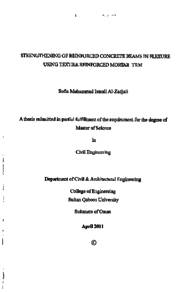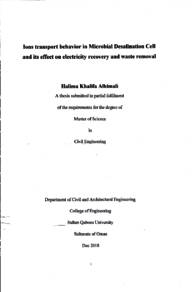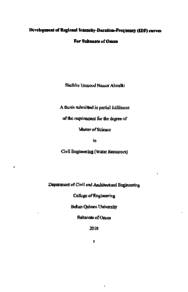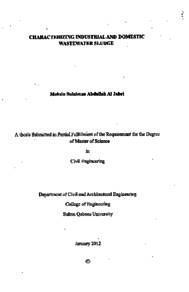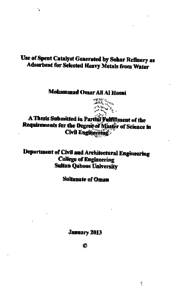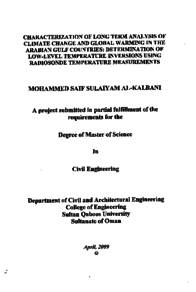Document
.Flexural behavior of concrete beams reinforced with hybrid FRP and steel bars
Publisher
Sultan Qaboos University
Gregorian
2019
Language
English
Subject
English abstract
This research study presents an experimental and theoretical investigation on the flexural behavior of concrete beams reinforced with hybrid glass fiber reinforced polymer (GFRP) and steel bars. The experimental work consisted of the construction and testing of twelve beams in the lab. Type of reinforcement, the ratio between steel and GFRP bars and length of steel bars were the main parameters in this study. All beams were tested under four- point bending set-up. The measurements included deflections, strains in reinforcement and concrete, number and propagation of cracks, ultimate capacity and mode of failure.
The theoretical part consisted of calculating the beams' capacities, load versus mid-span deflection curves, and load versus maximum crack width curves. The results indicated that the hybrid beams had higher flexural capacities compared to
the pure steel beam (4S8). This increase varied from 22 to 146%. Using the hybrid reinforcement enhanced the deflection behavior of the beams at service load level compared to the pure FRP reinforced beam. In addition, the results showed that the cracks in the GFRP reinforced beam can be restrained by using the hybrid system (steel and GFRP). Moreover, increasing the GFRP or steel reinforcement ratio resulted in an increase in the ultimate capacities, however, reduced the ductility of the beams. When comparing the behavior of beams with the same amount of hybrid reinforcement (GFRP+Steel), the beams with more GFRP reinforcement showed higher capacities than the beams with more steel reinforcement. This increase ranged between 15 and 39%. Reducing the steel length in hybrid beams changes the mode of failure to debonding failure. To have a yielding of steel before debonding, it was found that the development length should not be less than twice beam depth.
Comparisons between the experimental results and the theoretical predictions showed that the adopted models could predict the ultimate capacities of the beams as well as mid- span deflection and crack width at service load level of the beams with reasonable accuracy.
Arabic abstract
يقدم هذا البحث التجريبي دراسية عملية ونظرية حول سلوك العوارض الخرسانية المسلحة بقضبان من الحديد وقضبان من البوليمر المدعمة بألياف الزجاج (GFRP). تتألف الدراسة العملية من اثنتي عشرة عارضة من الخرسانة المسلحة. شمل البحث دراسة لفئة من العوامل الأساسية وهي: نوع التسليح المستخدم (Steel ، GFRP ، Hybrid ) ، نسبة الحديد إلى نسبة البوليمر المدعم بألياف الزجاج، وطول حديد التسليح، تم اختبار جميع العوارض باستخدام أحمال عند نقطتين. شملت القياسات كل من الإزاحة الرأسية، الاستطالة في التسليح و الخرسانة، قياس التفوق، قدرة التحمل، ونوع الانهيار. كما شمل البحت دراسة نظرية لحساب قدرة تحمل العوارض، حساب الإزاحة وحساب عرض الشقوق. أظهرت النتائج أن العوارض المسلحة يقضيان هجينة لديها قدرة تحمل أعلى من العارضة المسلح بقضبان حديد فقط. تراوحت نسبة هذه الزيادة من ۲۲ إلى 46 %. كما أن العوارض المسلحة بقضيان هجينة قللت من قيمة الإزاحة الرأسية و عرض الشقوق مقارنة بالعارضة المسلحة فقط يقضيان البوليمر المدعم بألياف الزجاج. كما أوضحت النتائج أن زيادة نسبة التسليح بال GFRP أو بالحديد في العوارض الهجينة يؤدي إلى زيادة قدرة تحمل العوارض لكنها تقلل من مرونتها. عند مقارنة سلوك العوارض الخرسانية الهجينة التي تم تدعيمها بنفس كمية التسليح مع اختلاف نسبة التسليح بين الحديد وقضيان البوليمر المدعم يألياف الزجاج وجد أن العوارض الخرسانية التي تحتوي على كمية أكبر من البوليمر المدعم بألياف الزجاج لديها قدرة تحمل أعلى من العوارض الخرسانية التي تحتوي على نسبة حديد أعلى، حيث تراوحت الزيادة في قدرة التحمل بين ۱۵-۳۹%. إن تقليل طول حديد التسليح يؤدي إلى تغيير نوع الانهيار حيث يؤدي إلى انفصال الحديد عن الخرسانة لمنع انفصال الحديد عن الخرسانة يجب أن يكون طول الحديد من أقصى عزم إلى طرف الحديد لا يقل عن ضعف عمق الخرسانة أظهرت المقارنة بين النتائج العملية والنتائج النظرية أن الطريقة المعتمدة في هذا البحت قادرة على حساب قدرة التحمل، الإزاحة، وعرض الشقوق للعوارض المسلحة بالقضبان الهجينة.
Member of
Resource URL
Same Subject
